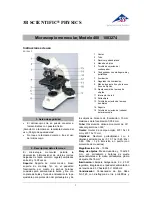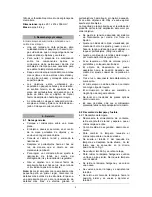
2
265 V, 50/60 Hz power supply
Condenser:
Abbe condenser N.A.1.25 NA 0.65
with iris diaphragm , filter holder and blue filter,
focussed via rack and pinion drive
Dimensions:
291 x 214 x 356 mm³ approx.
Weight:
5.6 kg approx.
3. Unpacking and assembly
The microscope is packed in a molded styro-
foam container.
•
Take the container out of the carton remove
the tape and carefully lift the top half off the
container. Be careful not to let the optical
items (objectives and eyepieces) drop down.
•
To avoid condensation on the optical com-
ponents, leave the microscope in the original
packing to allow it to adjust to room tem-
perature.
•
Using both hands (one around the pillar and
one around the base), lift the microscope
from the container and put it on a stable
desk.
•
The objectives will be found within individual
protective vials. Install the objectives into the
microscope nosepiece from the lowest
magnification to the highest, in a clockwise
direction from the rear.
•
Put the head onto the top of the stand and
tighten the head-lock-screw. Insert the eye-
piece into the tube.
4. Operation
4.1 General information
•
Set the microscope on a level table.
•
Place the object to be observed in the centre
of the specimen stage and clamp it to the
object guide.
•
Connect the mains cable to the net and turn
on the switch to get the object illuminated.
•
Make certain that the specimen is centered
over the opening in the stage.
•
To obtain a high contrast, adjust the back-
ground illumination by means of the iris dia-
phragm and the variable illumination control.
•
Rotate the nosepiece until the objective with
the lowest magnification is pointed at the
specimen. There is a definite “click” when
each objective is lined up properly.
NOTE:
It is best to begin with the lowest power
objective. This is important to reveal general
structural details with the largest field of view
first. Than you may increase the magnification
as needed to reveal small details.
When 100x
(oil) objective is chosen, objective oil must be
dripped onto the slide.
To determine the magnification at which you are
viewing a specimen, multiply the power of the
eyepiece by the power of the objective.
•
Adjust the holding brake to give a suitable
degree of tightness in the focusing mecha-
nism.
•
Adjust the coarse-focusing-knob which
moves the stage up until the specimen is fo-
cused. Be careful that the objective does not
make contact with the slide at any time. This
may cause damage to the objective and/or
crack your slide.
•
Adjust the fine-focusing-knob to get the im-
age more sharp and more clear.
•
Colour filters may be inserted into the filter
holder for definition of specimen parts.
Swing the filter holder out and insert colour
filters.
•
Use the knobs of the mechanical stage to
move the slide side-, back- and forwards.
The vernier provides accurate location of the
specimen area.
•
Always turn off the light immediately after
use.
•
Be careful not to spill any liquids on the mi-
croscope.
•
Do not mishandle or impose unnecessary
force on the microscope.
•
Do not wipe the optics with your hands.
•
Do not attempt to service the microscope
yourself.
4.2 Changing the lamp and fuse
4.2.1 Changing the lamp
•
Turn off the power switch, unplug the mains
plug and let the lamp cool down to avoid be-
ing burnt.
•
For safety reasons, remove the eyepiece.
•
To change the lamp lay the microscope on
its back to reach the lid on the bottom side.
•
Loosen screw C of the lamp socket and
push it outwards so that it is in the position
shown in Fig.1.
•
Loosen screw A and open the cover.
•
To remove the halogen lamp, use a cloth or
similar material. Do not touch the bulb with
the bare hand.
•
Lift out the halogen lamp and replace it with
a new one.
•
Close the cover and secure it with the
screw.
•
Push the lamp socket back into the original
position and tighten screw C.




































